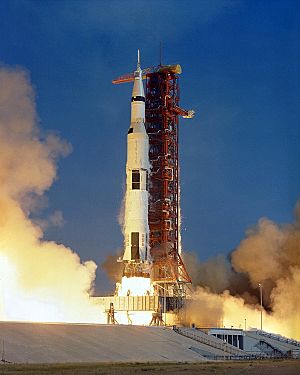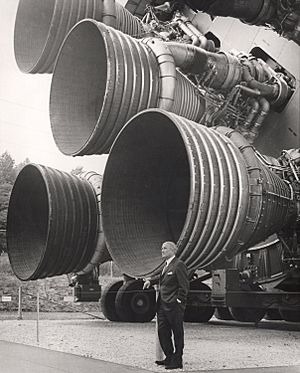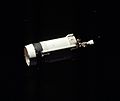Saturn V facts for kids

The launch of Apollo 11 on Saturn V SA-506, July 16, 1969
|
|
| Function | |
|---|---|
| Manufacturer |
|
| Country of origin | United States |
| Project cost | $6.417 billion in 1964–1973 dollars (~$42 billion in 2019 dollars) |
| Cost per launch | $185 million in 1969–1971 dollars ($1.23 billion in 2019 value), of which $110 million was for vehicle. |
| Size | |
| Height | 363.0 ft (110.6 m) |
| Diameter | 33.0 ft (10.1 m) |
| Mass | 6,540,000 lb (2,970,000 kg) |
| Stages | 2–3 |
| Capacity | |
| Payload to LEO (90 nmi (170 km), 30° inclination) | 310,000 lb (140,000 kg) |
| Payload to TLI | 107,100 lb (48,600 kg) |
| Associated rockets | |
| Family | Saturn |
| Derivatives | Saturn INT-21 |
| Comparable | |
| Launch history | |
| Status | Retired |
| Launch sites | LC-39, Kennedy Space Center |
| Total launches | 13 |
| Successes | 12 |
| Failures | 0 |
| Partial failures | 1 (Apollo 6) |
| First flight | November 9, 1967 (AS-501 Apollo 4) |
| Last flight | May 14, 1973 (AS-513 Skylab) |
| First stage – S-IC | |
| Length | 138.0 ft (42.1 m) |
| Diameter | 33.0 ft (10.1 m) |
| Empty mass | 287,000 lb (130,000 kg) |
| Gross mass | 5,040,000 lb (2,290,000 kg) |
| Engines | 5 Rocketdyne F-1 |
| Thrust | 7,891,000 lbf (35,100 kN) sea level |
| Specific impulse | 263 seconds (2.58 km/s) sea level |
| Burn time | 168 seconds |
| Fuel | RP-1/LOX |
Saturn V was the name of the rocket type used by NASA in the Apollo program. The Saturn V carried Apollo 11 and its crew to the Moon in 1969. Much of the rocket was designed by German engineer and scientist Wernher von Braun. There were 32 Saturn rockets launched, and the Saturn V was the largest. There were 15 Saturn V rockets produced and 13 were launched. There were two unmanned Saturn V test flights, and the first manned Apollo flight using a Saturn V was Apollo 8 launched on December 21, 1968.
The Saturn V rocket was a three stage design. It stood 110.7 m (363 ft) high and weighed 2,903,020 kg (6,400,064 lb). The first rockets were able to carry a load of 44,600 kg (98,326 lb). This was increased to 46,800 kg (103,176 lb) for the later Apollo missions. The first and second stages gave the power to lift the rocket off the Earth. The first and second stages each had five engines. The first stage used a fuel made of kerosene and liquid oxygen. The other stages used a mix of liquid oxygen and liquid hydrogen.
The first stage engines fired for 168 seconds which was able to lift Apollo to a height of 67 km (42 mi) and about 93 km (58 mi) down range from the launch site. The second stage fired for about 8 minutes to speed Apollo through the upper atmosphere. At this time the speed was 25,182 km/h (15,647 mph)
The third stage was used for 2.5 minutes to put Apollo into an Earth orbit. This was at a height of 191.2 km (119 mi) above the Earth. The third stage was restarted and fired for 6 minutes to increase the speed to 40,320 km/h (25,054 mph) needed to send Apollo off to the Moon.
Images for kids
-
An S-II stage hoisted onto the A-2 test stand at the Mississippi Test Facility
-
The instrument unit for the Apollo 4 Saturn V
-
Condensation clouds surrounding the Apollo 11 Saturn V as it works its way through the dense lower atmosphere.
-
Saturn V Rocket -- Johnson Space Center
-
Saturn V's F-1 engines—Rocket Park, Houston
See also
 In Spanish: Saturno V para niños
In Spanish: Saturno V para niños


















